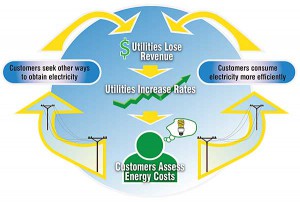Front Porch Blog

The complex tax credits, state and federal incentives, and cost of renewable energy can make your head spin. But with increased adoption and efficiency, distributed generation is creating a different kind of cycle.
The most recent issue of The Appalachian Voice includes a story about distributed energy generation, especially rooftop solar, and the ways communities, nonprofits and entrepreneurs are helping each other democratize the grid.
But as they do, we’re seeing just how much old-school utilities are entrenched in old-school models that, while a bit dated, are still dominant.
I ended that story with a bit of hope by reiterating that “regardless of the scale or speed, greater education and supportive policies have already created consumer participation and a movement to democratize the grid,” and wondering whether “utilities will use their power to lead or find that they have been forced to follow?”
Well, a lot has happened on the distributed energy frontier in the past few months. Summer is a good time to go solar after all.
For a little perspective, let’s turn to a July report from the Center for American Progress on the changing ways power is produced and delivered.
Richard Caperton, the managing director of CAP’s energy program and the author of the report, makes his case with the common comparison, one that ends up as more of a cautionary tale, between the recent revolutions in the telecommunications industry and advancements underway in the energy sector.
Even as broadband Internet and cell service become more essential to everyday life, Caperton writes that an estimated 19 million Americans live in areas deemed too expensive to serve by high-speed Internet providers. But there’s an upside:
“Even though traditional landline telephone-service providers have suffered, most Americans now have dramatically better communications services. The same will be true in energy because people will only switch away from current providers if the alternatives are better.”
The problem arises, in telecom and the energy sector, when companies built on the principle of universal access to services like telephone landlines and electricity get caught in the cycle of providing outdated services at increasingly higher costs. And the cycle has already started spinning, giving rise to the recent insidery phrase: the “utility death spiral.”

Distributed generation poses a perpetual threat
to utilities’ business model. As power providers lose
revenue and raise rates, renewables and efficiency
become more attractive.
The perpetual threat that distributed generation poses to the traditional utility business model comes as sources like rooftop solar become more attractive to consumers, increasing adoption and forcing power providers to raise rates to recover lost revenue and maintain the grid that those without access still rely on.
Sure, solar still only accounts for about 1 percent of electricity in the United States. But because distributed generation’s threat to utilities increases with installed capacity, power companies, investors and policymakers ignore it at their peril. Or as David Roberts at Grist wrote in his excellent series that helped many understand utilities, “investors are sleepwalking into a maelstrom.”
Caperton recently joined Greentech Media’s Energy Gang Podcast to discuss what lessons the utility sector can learn from other industries that have already navigated the shift to distributed technologies.
Doubt the existence of death spiral? Look west, where some of the states with the most developed solar industries in the country are already seeing the death spiral start to spin. A study released last week by the California Public Utilities Commission found that, as more homeowners install solar, utility costs could increase by $75 million to $254 million per year.
Closer to home, battles between utilities and solar advocates are underway in Tennessee and Georgia. The Tennessee Valley Authority caught has been catching flak for the inexplicably low cap on its Green Power Providers program, leading Steve Johnson of the solar contractor LightWave Solar to accuse TVA of denying the market access to the grid. And in a win for solar advocates in Georgia, the Public Service Commission ordered Georgia Power to add an additional 525 megawatts to their 210-megawatt solar production plan.
Lest our limited renewable policies hold us back or put too many ratepayers at risk to be rewarding to the whole, utilities and policymakers in Appalachia and the Southeast should plan ahead. The solar industries in states such as North Carolina, Tennessee and Georgia are coming along swimmingly despite attempts to reduce incentives and rollback renewable portfolio standards.
With recent headlines like “Utility Shocked to Find It’s Already Dead” and “Adapt or Die,” this can all sound pretty ominous. But the economic and environmental benefits, and the cost-reducing potential of distributed generation — yep, reducing is right — is ours for the taking. At least they are if traditional utilities, alternative energy companies and regulators can make nice and find a way forward.
Whichever way the winds that motivate utilities blow, disrupting distributed generation out of an aversion to change will make it harder for all of us to create a future with less pollution, and with the affordable, reliable and efficient energy we know is possible.
Read The Appalachian Voice to learn more about opportunities for distributed generation and community-owned renewable energy in our region.
PREVIOUS
NEXT
Related News

Leave a comment
Your email address will not be published. Required fields are marked *
